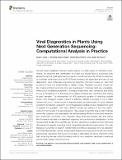Files in this item
Viral diagnostics in plants using next generation sequencing : Computational analysis in practice
Item metadata
| dc.contributor.author | Jones, Susan | |
| dc.contributor.author | Baizan-Edge, Amanda | |
| dc.contributor.author | MacFarlane, Stuart | |
| dc.contributor.author | Torrance, Lesley | |
| dc.date.accessioned | 2017-11-30T12:30:05Z | |
| dc.date.available | 2017-11-30T12:30:05Z | |
| dc.date.issued | 2017-10-24 | |
| dc.identifier | 251666038 | |
| dc.identifier | 5b68e548-21e4-4615-932f-5e689fff3032 | |
| dc.identifier | 29123534 | |
| dc.identifier | 85034089477 | |
| dc.identifier | 000413531800001 | |
| dc.identifier.citation | Jones , S , Baizan-Edge , A , MacFarlane , S & Torrance , L 2017 , ' Viral diagnostics in plants using next generation sequencing : Computational analysis in practice ' , Frontiers in Plant Science , vol. 8 , 1770 . https://doi.org/10.3389/fpls.2017.01770 | en |
| dc.identifier.issn | 1664-462X | |
| dc.identifier.other | RIS: urn:1BBD3A17F2481712CB4C66D52AD81A80 | |
| dc.identifier.other | PubMedCentral: PMC5662881 | |
| dc.identifier.uri | https://hdl.handle.net/10023/12201 | |
| dc.description | AB, LT, SJ, and SMwere funded by a BBSRC Tools and Resources (UK) grant: BB/N023293/1. The work of LT, SJ, and SM was additionally supported by the Scottish Government’s Rural and Environment Science and Analytical Services division (RESAS). | en |
| dc.description.abstract | Viruses cause significant yield and quality losses in a wide variety of cultivated crops. Hence, the detection and identification of viruses is a crucial facet of successful crop production and of great significance in terms of world food security. Whilst the adoption of molecular techniques such as RT-PCR has increased the speed and accuracy of viral diagnostics, such techniques only allow the detection of known viruses, i.e. each test is specific to one or a small number of related viruses. Therefore, unknown viruses can be missed and testing can be slow and expensive if molecular tests are unavailable. Methods for simultaneous detection of multiple viruses have been developed, and (NGS) is now a principal focus of this area, as it enables unbiased and hypothesis-free testing of plant samples. The development of NGS protocols capable of detecting multiple known and emergent viruses present in infected material is proving to be a major advance for crops, nuclear stocks or imported plants and germplasm, in which disease symptoms are absent, unspecific or only triggered by multiple viruses. Researchers want to answer the question “how many different viruses are present in this crop plant?” without knowing what they are looking for: RNA-sequencing (RNA-seq) of plant material allows this question to be addressed. As well as needing efficient nucleic acid extraction and enrichment protocols, virus detection using RNA-seq requires fast and robust bioinformatics methods to enable host sequence removal and virus classification. In this review recent studies that use RNA-seq for virus detection in a variety of crop plants are discussed with specific emphasis on the computational methods implemented. The main features of a number of specific bioinformatics workflows developed for virus detection from NGS data are also outlined and possible reasons why these have not yet been widely adopted are discussed. The review concludes by discussing the future directions of this field, including the use of bioinformatics tools for virus detection deployed in analytical environments using cloud computing. | |
| dc.format.extent | 10 | |
| dc.format.extent | 461266 | |
| dc.language.iso | eng | |
| dc.relation.ispartof | Frontiers in Plant Science | en |
| dc.subject | Viral diagnostic | en |
| dc.subject | Next generation sequencing (NGS) | en |
| dc.subject | Crop protection | en |
| dc.subject | Food security | en |
| dc.subject | Bioinformatics & computational biology | en |
| dc.subject | QH301 Biology | en |
| dc.subject | QA75 Electronic computers. Computer science | en |
| dc.subject | T-NDAS | en |
| dc.subject | SDG 2 - Zero Hunger | en |
| dc.subject.lcc | QH301 | en |
| dc.subject.lcc | QA75 | en |
| dc.title | Viral diagnostics in plants using next generation sequencing : Computational analysis in practice | en |
| dc.type | Journal item | en |
| dc.contributor.sponsor | BBSRC | en |
| dc.contributor.institution | University of St Andrews. School of Biology | en |
| dc.contributor.institution | University of St Andrews. Biomedical Sciences Research Complex | en |
| dc.identifier.doi | https://doi.org/10.3389/fpls.2017.01770 | |
| dc.description.status | Peer reviewed | en |
| dc.identifier.grantnumber | BB/N023293/1 | en |
This item appears in the following Collection(s)
Items in the St Andrews Research Repository are protected by copyright, with all rights reserved, unless otherwise indicated.

